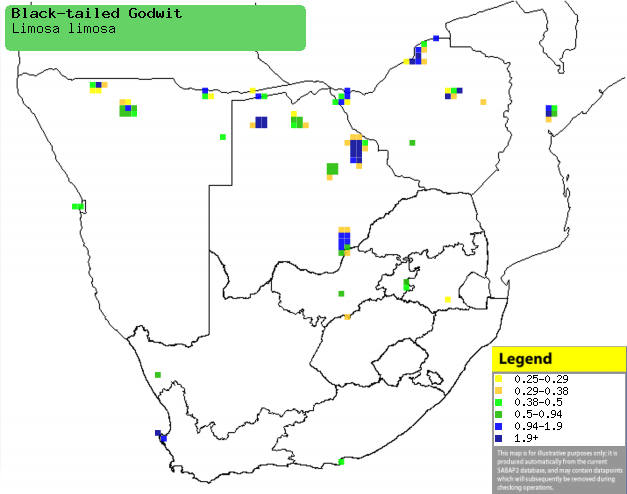|
Limosa limosa (Black-tailed
godwit)
Swartstertgriet [Afrikaans]; Grutto [Dutch]; Barge à
queue noire [French]; Uferschnepfe [German]; Maçarico-de-bico-direito
[Portuguese]
Life
> Eukaryotes >
Opisthokonta
> Metazoa (animals) >
Bilateria >
Deuterostomia > Chordata >
Craniata > Vertebrata (vertebrates) > Gnathostomata (jawed
vertebrates) > Teleostomi (teleost fish) > Osteichthyes (bony fish) > Class:
Sarcopterygii (lobe-finned
fish) > Stegocephalia (terrestrial
vertebrates) > Tetrapoda
(four-legged vertebrates) > Reptiliomorpha > Amniota >
Reptilia (reptiles) >
Romeriida > Diapsida > Archosauromorpha > Archosauria >
Dinosauria
(dinosaurs) > Saurischia > Theropoda (bipedal predatory dinosaurs) >
Coelurosauria > Maniraptora > Aves
(birds) >
Order: Charadriiformes > Family: Scolopacidae
Distribution and habitat
Breeds in patches from Iceland south to France and east to
Manchuria and Siberia, heading south in the non-breeding season to eastern
Australia to sub-Saharan Africa (especially within 30° of the equator). It is a
rare non-breeding migrant to southern Africa, with several dozen records spread
across the region (largely excluding Mozambique). Occurs in wide variety of
habitats, generally preferring lake margins, marshes, swamps, irrigated lands
with soft substratum and coastal wetlands.
|
 |
|
Distribution of Black-tailed godwit in southern Africa,
based on statistical smoothing of the records from first SA Bird Atlas
Project (©
Animal Demography unit, University of
Cape Town; smoothing by Birgit Erni and Francesca Little). Colours range
from dark blue (most common) through to yellow (least common).
See here for the latest distribution
from the SABAP2. |
Movements and migrations
Arrives in its West African non-breeding
grounds in July, arriving a few months later in East Africa and
staying until about April. Most southern African records are in the
period from December-April; most birds which reach the region are
thought to originate from East Africa.
Food
It eats molluscs, polychaete worms, plant material and fly
larvae, doing most of its foraging in deeper water (5-10cm) than other waders,
pecking the soft mud before probing deeply once it has located prey. The following food items have been recorded
in its diet:
- invertebrates
- molluscs
- polychaete worms
- fly larvae (Diptera)
- plants
- seeds
- Oryza sativa (Cultivated rice)
- Oryza breviligulata (Wild rice)
- seeds and tubers of other water plants
Threats
Not threatened.
References
-
Hockey PAR, Dean WRJ and Ryan PG 2005. Roberts
- Birds of southern Africa, VIIth ed. The Trustees of the John Voelcker
Bird Book Fund, Cape Town.
|
